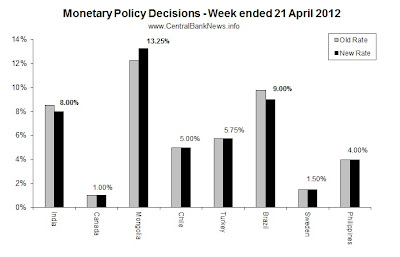By MoneyMorning.com.au
While a high oil price is good news for big producers in the Middle East, it’s also bad news.
Simply because a high oil price makes other projects viable.
And that means more price and supply competition. It explains why Saudi Arabian oil minister, Ali al-Naimi is so keen to make sure the market still knows who’s in charge. As Bloomberg News recently reported:
“Saudi Arabia said it could potentially raise output capacity to 15 million barrels a day, from 12.5 million barrels a day, using new oil fields if needed.”
If you ask us, it’s all talk. Saudi Arabia doesn’t really want to knock down the oil price. It just wants to make investors, explorers and producers think it can knock down the price if it wants.
In the long term, lower oil prices are actually better for the Middle East because it makes competing oil fields less viable.
Trouble is, in the short term, Middle East dictators like high oil prices because they can buy more trinkets (football teams, London and New York property, and so on).
Also, they’re afraid of what could happen if prices fall and they can no longer afford the handouts they’ve promised their oppressed citizens.
The memory of what happened to Libya’s Colonel Gadaffi is still fresh in their minds.
So the idea that the oil price will fall because Saudi Arabia is trying to talk the price down, is a little far-fetched. High oil prices are here. And in our view, they’re here to stay.
Yet it’s not just Middle East dictators who will pocket the profits. Aussie companies investing in new energy frontiers are set to profit too…
For all the talk about replacing oil as an energy source, it’s still arguably the world’s most important form of energy.
And that’s not likely to change for some time yet. Even with the rise of natural gas.
This chart from Professor Michael Economides at the University of Houston shows that fossil fuels will still be the world’s main energy source by 2030…
As you can see, by 2030 he expects coal, gas and oil will contribute 80% to energy supply. Green fuels such as wind and solar will contribute no more than 1%!
So, where will the increased oil supply come from?
Despite the risks, we believe East Africa is the area to watch…
Under-Explored East Africa
You see, for years, when oil was just USD$20 per barrel, certain areas of the world were no-go zones. They were politically unstable… geologically inaccessible… or just plain not-worth-the-risk.
The east coast of Africa, fell into all of those categories.
But with oil at USD$100 per barrel, the reward has started to offset the risk. But it’s still risky. Very risky.
To highlight this, Norwegian oil company, Statoil is investing in the area. It has hired armed security guards to patrol its offshore assets to protect them from pirate attack!
But even machine-gun toting pirates can’t keep the explorers away.
And why would they? The east African coastline is almost completely unexplored when it comes to oil and gas.
That’s highlighted by these amazing numbers from U.K-based explorer and producer, Afren plc…
Source: Afren plc
For every 70 wells drilled in North, West and Central Africa, only one well has been drilled in East Africa.
Oil company, Africa Oil, makes a similar comparison. This time comparing the triangle of Kenya, Somalia and Ethiopia with the North Sea and the Suez Basin:
Source: Africa Oil Corp
Fewer than 200 wells drilled, compared to 7,706 for the North Sea and Suez Basin. That’s just 2.5% the number of the wells drilled, in an area 10-times larger!
As the Financial Times recently reported:
“Statoil set the oil industry abuzz late last month when it announced it had found large volumes of natural gas off the coast of Tanzania, confirming east Africa’s reputation as one of the energy world’s most promising new frontiers.”
See what we mean? There’s a huge opportunity for energy companies that can get in early.
Big Gains in Oil from Africa’s Pirate Coast
For instance, take London-listed, Cove Energy [LON: COV]. In 2009 it was trading for 18.5p. Today it’s trading for 211p… a gain of 1,040% in just over two years.
It’s all thanks to a lot of hard work, risk-taking, and a takeover offer by energy multi-national, Royal Dutch Shell [LON: RDSA].
The prized asset Shell is after? Cove’s east African portfolio. It includes a potential 30 trillion cubic feet of gas in place (5.2 billion barrels of oil equivalent) off the Mozambique coast.
So whether it’s oil or gas, east Africa is currently the speculator’s region of choice. But, it comes with plenty of risk… not just drilling risk, but pirate risk too!
If you can stomach that, the upside could mean triple-digit percentage gains. That’s why we’ve picked a number of oil stocks in Australian Small-Cap Investigator that are well placed to gain if we’re right about the surge in east African oil investment.
To find out more on this story, and which stocks we believe are best placed to gain, click here…
Cheers.
Kris.
The Most Important Story This Week…
Stock markets price risk. But risk is the very thing that scares investors about the stock market. Investors know shares offer potentially massive gains. But they’re naturally more concerned with not losing money. This often leads them to concentrate their money in Australia’s biggest and most dominant companies. These industry titans offer the image of stability and assurance – so-called “blue chip” stocks. Investors do this because they think it is a “safer” strategy. They’re trying to avoid risk but get exposure to making money in the stock market. But what if that idea is completely wrong?
Since 2007, the ASX/20 – the twenty largest companies listed on the Australian Stock Exchange – has lost 15%. That’s six years of going backwards. Investors would have been better putting their money in the bank – except they never would have had a chance of making eye-watering gains as only the share market can offer. You have to be in it to win it. But what if there was a way to both embrace and minimise risk? What type of money could you make? How much would you need to risk? Kris Sayce has a strategy – as he explains in How to Use Small-Cap Stocks to Beat the Buy-and-Hold Blue Chips
Other Recent Highlights…
Kris Sayce on How You Can Use Government Intervention to Profit on the Stock Market: “The strategy involves buying a specific asset class that could give you the best return for the risk involved – small-cap stocks. But hang on. Isn’t government intervention and red-tape bad for small companies? Aren’t you better off investing in big companies that can exploit loopholes… If you follow conventional wisdom, that sounds right. But it’s also completely wrong. Here’s why…”
Kris Sayce on Two Down and Dirty Ways to Track Down Undervalued Small-Cap Stocks: “Looking for value (and growth) is the core of small-cap investing. You look for small cap stocks that are undervalued by other investors and where there’s the opportunity for explosive growth. You could call them small-cap Moneyball stocks. And here are two of the best ways we know you could look for them…”
Keith Fitz-Gerald on Stock Market Volatility: How to Beat the Market at its Own Game: “Most investors head for the hills when volatility rises. Successful traders, on the other hand, embrace it because they know stock market volatility represents an opportunity. I find this especially ironic considering how often I hear individuals tell me they invest because they want the “big gains.” Because most of the time they choke… Instead of buying when prices are low, they head for the exits. This costs them big time.”
Kris Sayce on How to Make the Most Out of Small Cap Investing: “We’ve targeted three big themes: “creative destruction”, “disruptive technology” and “entrepreneurial vision”. Understanding why these are important and the role they play in the economy will be vital to making money from small-cap stocks in 2012. But in case you’re not familiar with these themes or you need a refresher, here’s a quick rundown…”
Kris Sayce on Why You MUST Speculate: “If you want any chance of getting ahead, you must speculate. Four central banks – the U.S. Federal Reserve, European Central Bank, Bank of Japan and Bank of England – have rigged the stock, bond and commodity markets. Their goal is to make stocks fall, but without causing a terrible crash. But why on earth would they do that?”

A Tale of Oil and African Pirates








